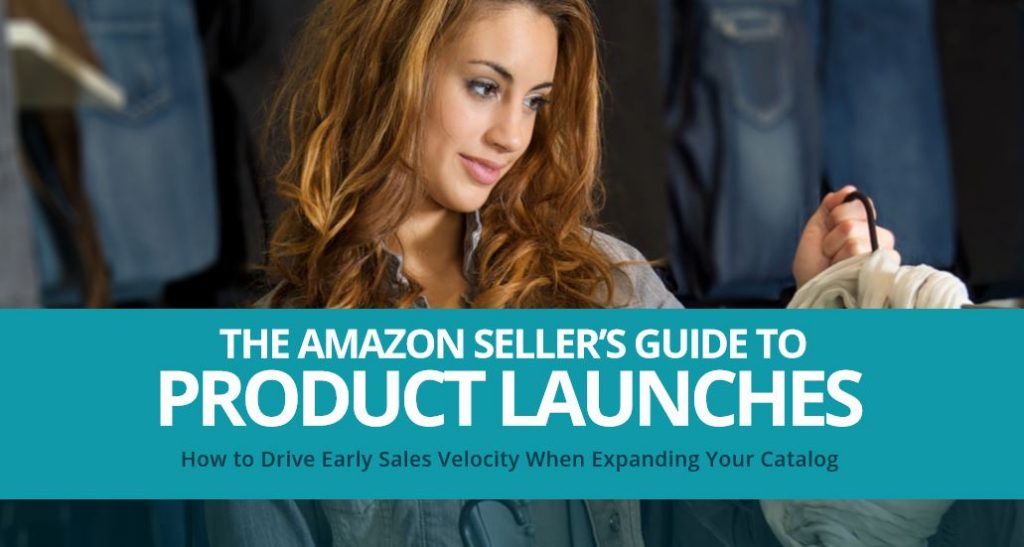How to Launch New Products on Amazon


From choosing the right product to advertising techniques & inventory management—there’s a lot of factors to carefully consider when launching a new product on Amazon.
Our latest white paper, “The Amazon Seller’s Guide to Product Launches“ covers everything sellers need to know about expanding their catalog and launching a successful product on the Marketplace including: Product Sourcing, Manufacturing, Amazon Advertising Techniques, and Tracking & Reporting.

If you don’t have time to read through the full guide, we’ve compiled a checklist below:
Whether searching for your first ever product, or looking to add new products to your business, according to Amazon product research providers, JungleScout – this is the stage where a majority of seller get stuck, or waste money on products that will never fly.
Criteria that you should always keep in mind when choosing a new winning product include price, shipping, sourceable, seasonality, demand, & competition.

When scoping our new product ideas, the Amazon Best Sellers list is a great place to start. There will be lots of inspiration, but also high competition. From there you can drill down into Amazon sub-categories.

Dut don’t stop there – you can find product and niche ideas in lots of places such as:
Beyond product discovery, there’s also a variety of research you should invest time in including “verifying demand, spying on competition, and organizing your data”, which all can be found in more detail in our Amazon Product Launch Guidebook.
The ideal approach to supply chain management, and one that the very successful businesses have figured out, is to have all aspects of the supply chain organized, managed and seamlessly operating in concert.
According to Guided Imports (a one stop solutions provider for all sourcing, logistics, and manufacturing needs in China), this ensures that the entire supply chain can be overseen and adjusted effectively and efficiently from one aggregated point of command.
 This is especially significant when a business is growing (or wants to grow) and all aspects of the supply chain need to be accelerated in unison to match the growth rate.
This is especially significant when a business is growing (or wants to grow) and all aspects of the supply chain need to be accelerated in unison to match the growth rate.
The bottom line is: If you don’t have a supply chain management solution put into place, you’re limited on growth. Period.
However, if you decide to put one in place, you’re limited to choosing between low cost/dangerous options like a sourcing agent, which puts incredible risk on your brand by locking yourself into a single middleman, or settling with an option that carries high setup fees and annual costs that can put a very immediate and severe strain on your business as a whole.
The sad fact, for most businesses growing as an e-commerce company, is that once you reach a certain ceiling of your own internal purchasing capabilities, it can be incredibly difficult to push through and continue to grow.
That’s just one of the many reasons why Guided Imports was founded years ago and has since been steadily growing as companies realize there is another option that makes more sense for their business.
Click here to learn more about manufacturing and supply chain management in our full length guide.
Now that Amazon no longer permits free or discounted products in exchange for reviews, advertisers are seeking alternative ways to gain momentum for new product launches on the Marketplace.
One theory is to implement the Sponsored Products Sales Velocity Strategy which involves repricing, as well as aggressive bidding on certain keywords to improve organic ranking, and ultimately increase conversions.
 As an agency, we analyze how much we need to spend, how high the bids need to be, and which keywords we want to bid on to determine what type of organic placement we can achieve for the new product.
As an agency, we analyze how much we need to spend, how high the bids need to be, and which keywords we want to bid on to determine what type of organic placement we can achieve for the new product.
“It’s not simply—let’s cut the price in half and double the bid,” David Cooley, Manager, Marketplace Channels Operations at CPC Strategy said. “There’s actually a lot of analysis that goes into it.”
“When launching a product, it’s also important to utilize your email groups and/ or Facebook groups (especially if you have a decent Facebook following) to drive off-Amazon traffic to your listings. For example, you can advertise promotions for your product on Facebook and push that traffic towards your Amazon page,” Cooley said.
Off-Amazon promotions build product and brand awareness. Funneling these promos directly back to Amazon is another way to increase overall sales velocity, conversion rate and review count for the new product.

So how can advertisers drive traffic to Amazon?
Utilize Facebook, Instagram & Email Groups – As seen in the example below, use Facebook posts ads aimed at target audience segments to generate sales and overall product awareness. You can also implement email blasts if a business has an existing customer database and sees value in driving traffic to Amazon as opposed to ecommerce site in order to build Amazon channel growth.
BLOG POST: “How to Create the Best Facebook Ads“
 Be Aware of Your Buy Box Percentage – Sellers should always be aware of their Buy Box percentage. If a seller does not own the Buy Box, when a customer clicks on the ad and is directed to Amazon, they are likely to lose the sale.
Be Aware of Your Buy Box Percentage – Sellers should always be aware of their Buy Box percentage. If a seller does not own the Buy Box, when a customer clicks on the ad and is directed to Amazon, they are likely to lose the sale.
If you are the manufacturer, eventually the same will come back to you but if you are the reseller and not in the Buy Box, you are probably paying for someone else’s order (conversion).

Leverage Influencers – Influencer Marketing is a powerful strategy that incorporates social media and content to build relationships with trusted people in your industry and drive your brand’s message to a target audience.
Whether an influencer’s audience is small or large, they have the ability to communicate valuable content to your current or potential consumers via blogs or social media in a way that traditional advertising efforts might not be able to.
BLOG POST: “The Ultimate Influencer Marketing List“

In order to optimize your business and manage your inventory, you should have a good grasp of your inventory costs. Once you know this, you can look into ways to automate, reduce costs, and improve processes.
According to Skubana, it’s common for a small percentage of stock to make up the largest percentage of profits. Inventory valuation means identifying these profitable items, as well as the non-profitable ones (dead stock, or slow-moving items).
Value inventory to prioritize stock, and invest more in products that make you the most money, while eliminating low value products. Cutting stock can be hard, but keeping low-value stock may have a bigger cost on your company than you realize.
Just in Time (JIT) inventory management uses inventory forecasting to determine how much you sell each period, so you can order just enough inventory to meet demand.
You then set up re-order alerts that orders replacement stock just in time to avoid selling out. By moving underperforming items to minimum stock level, you reduce any dead stock and free up warehouse space.
Want to learn more? “The Amazon Seller’s Guide To Product Launches“
